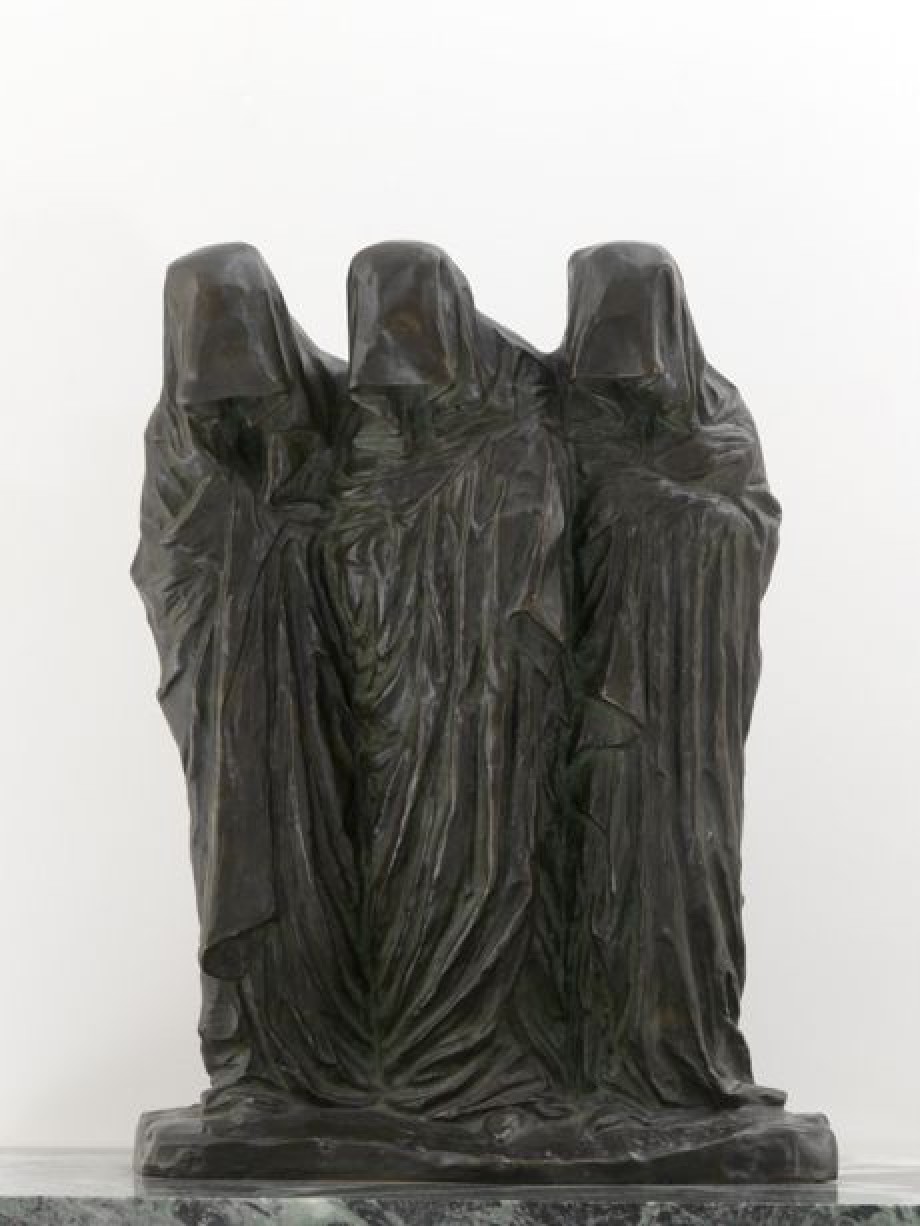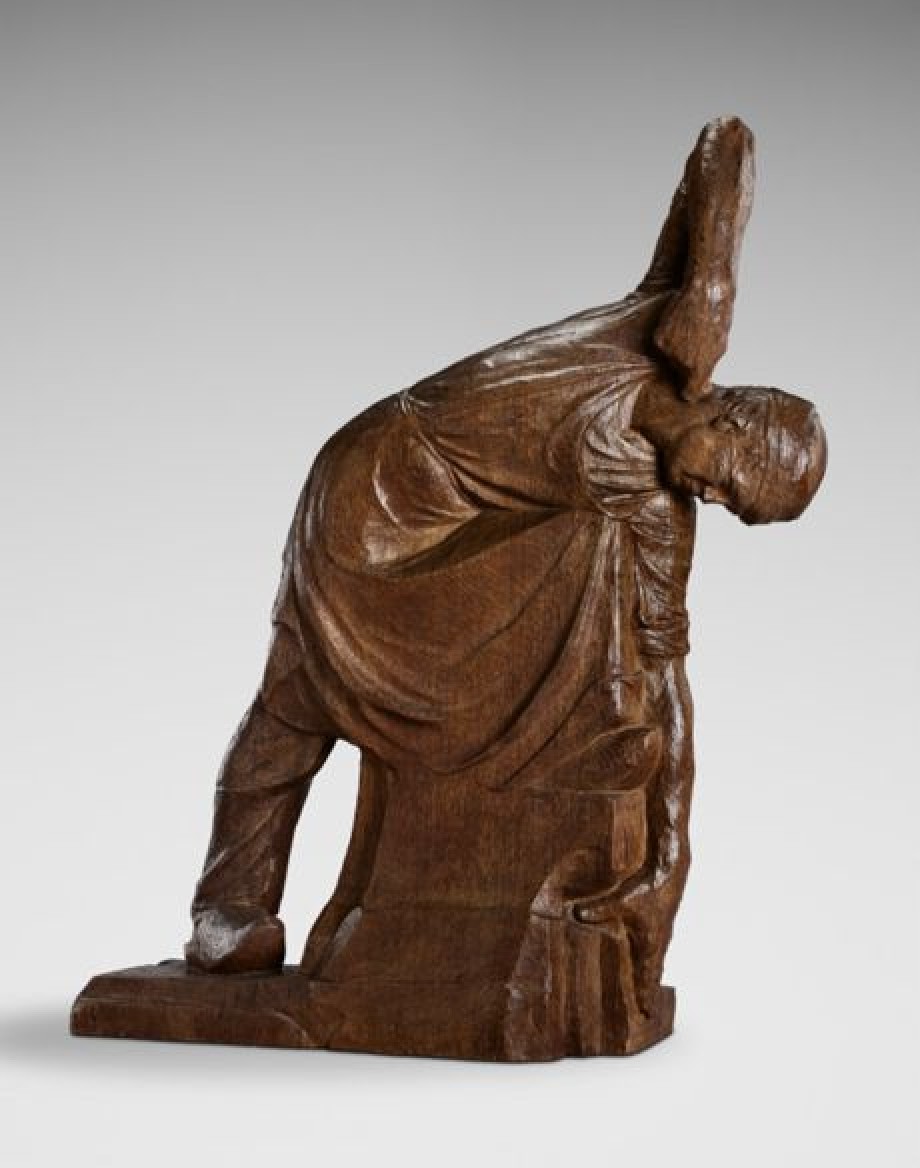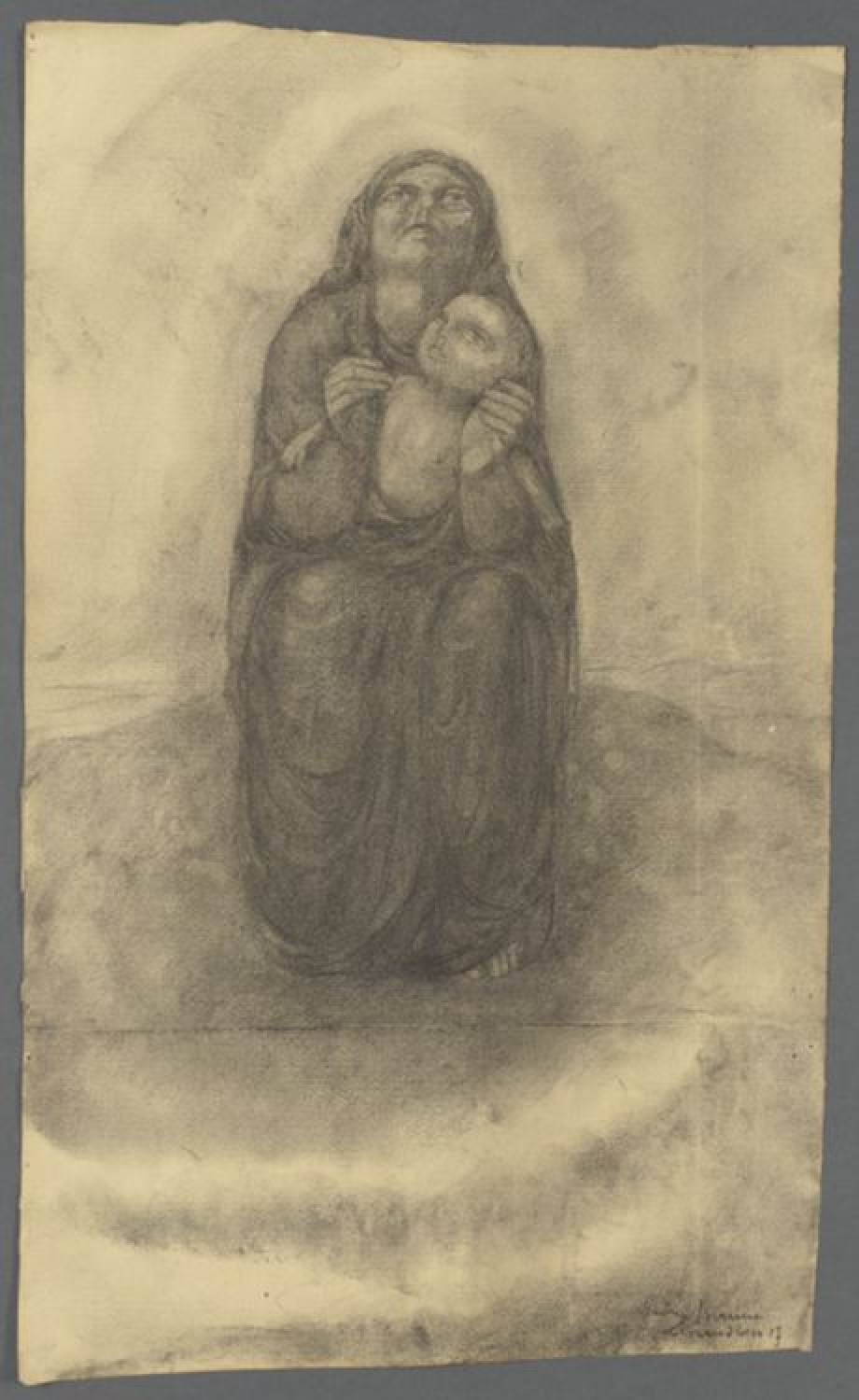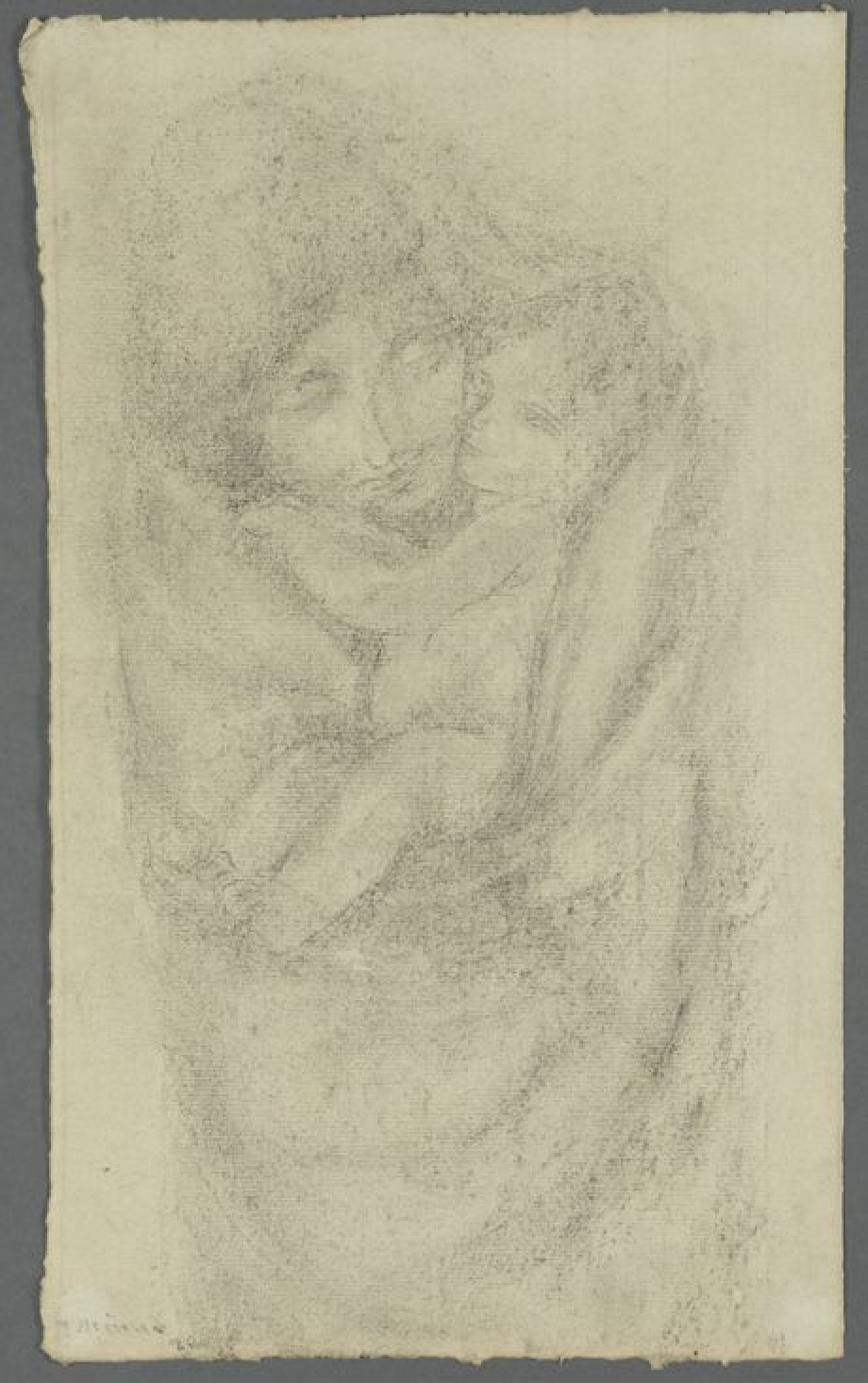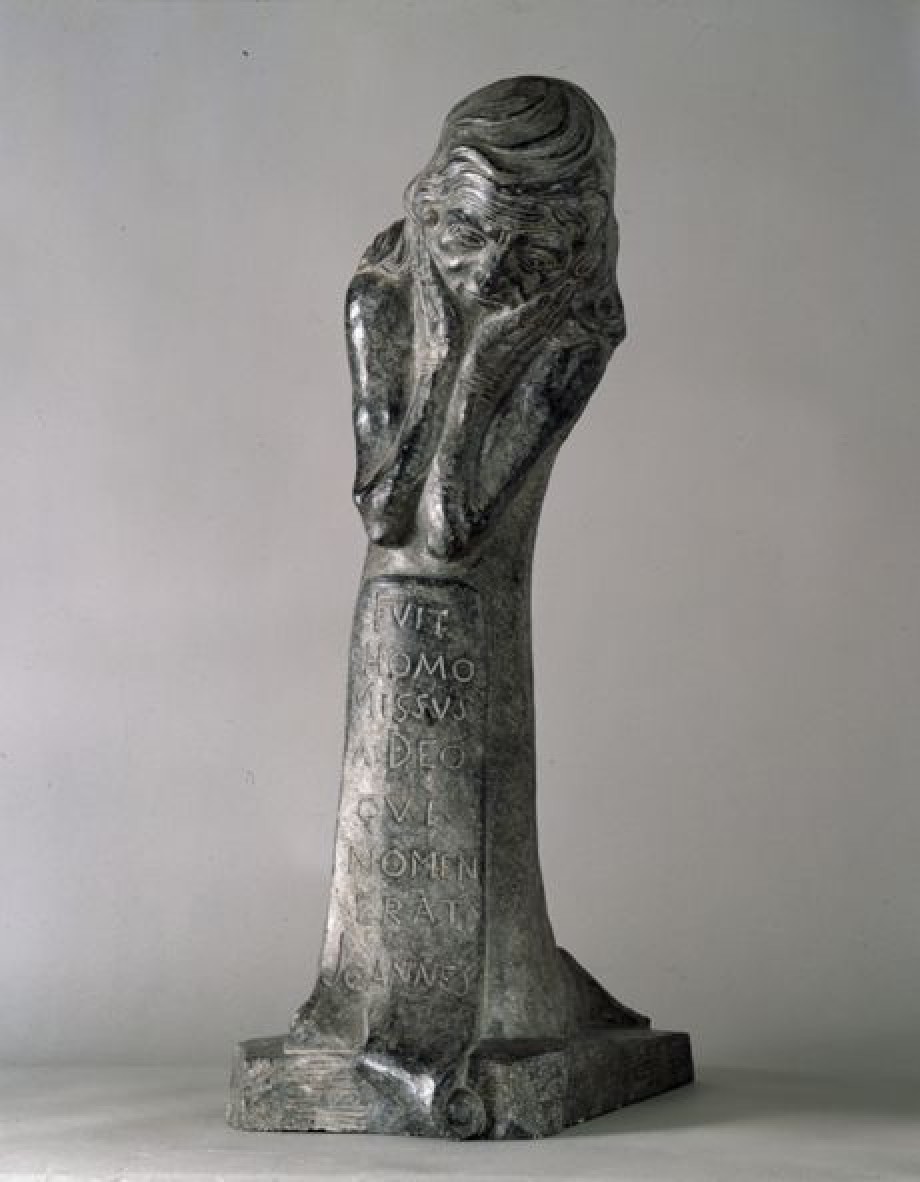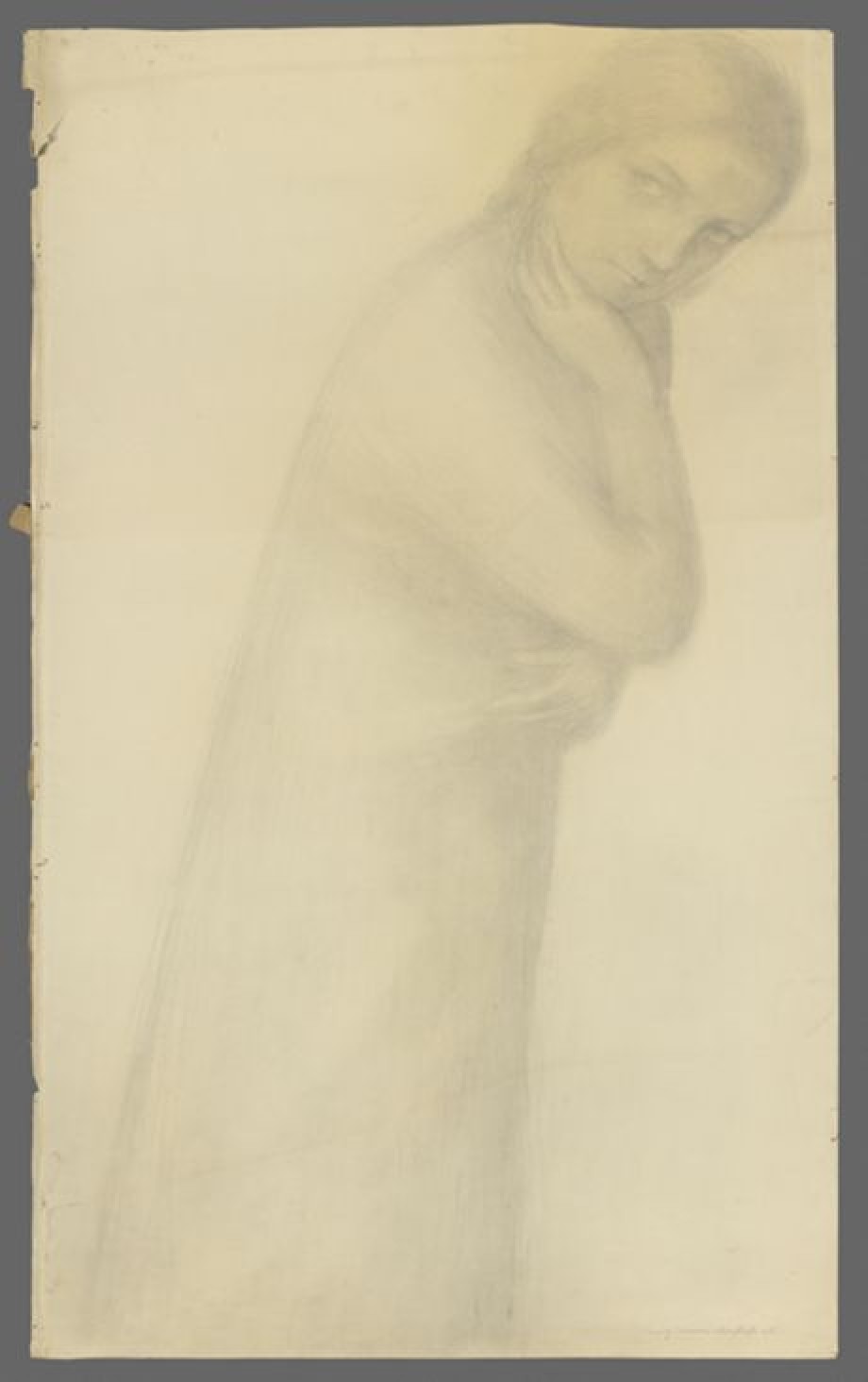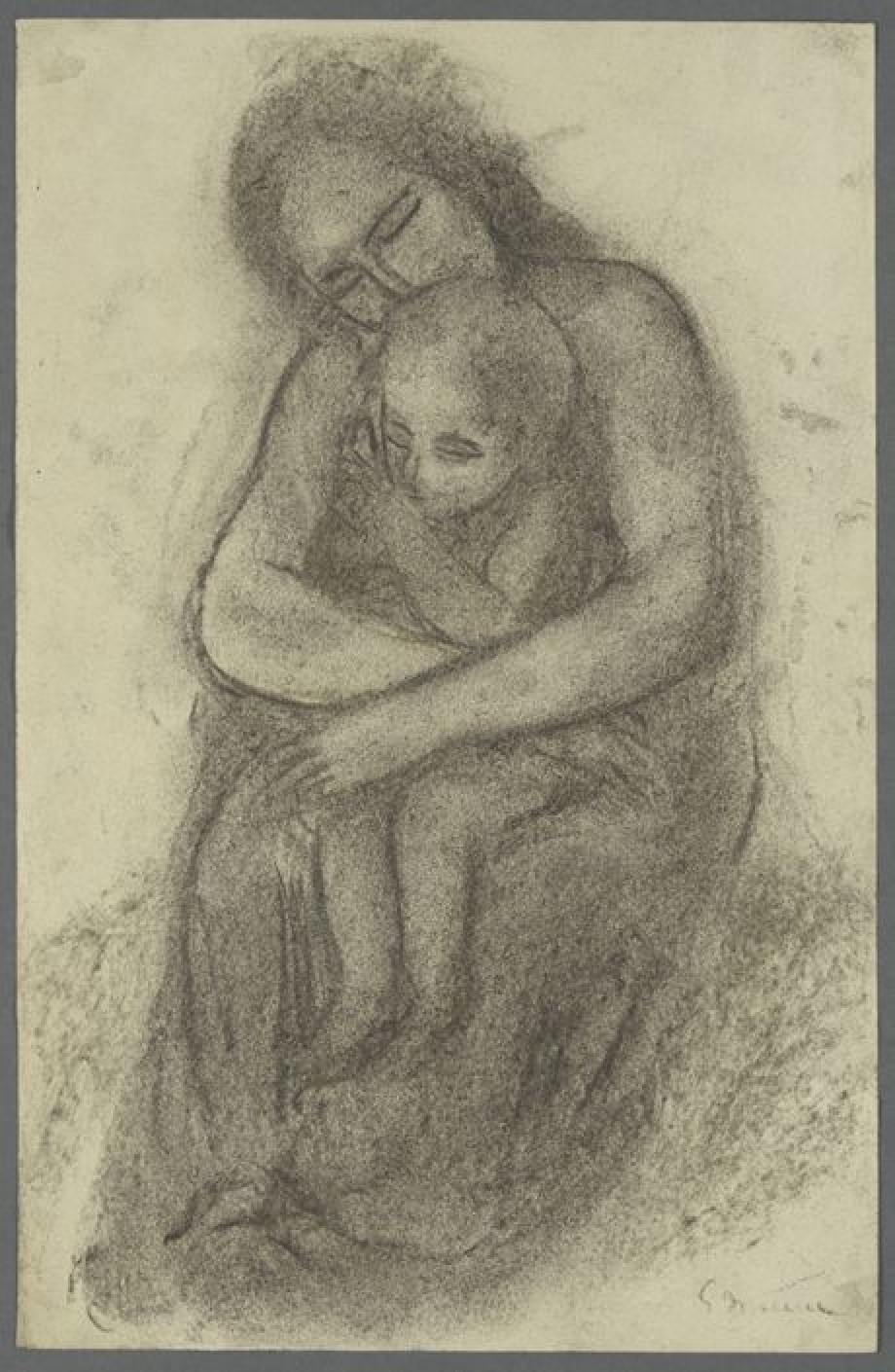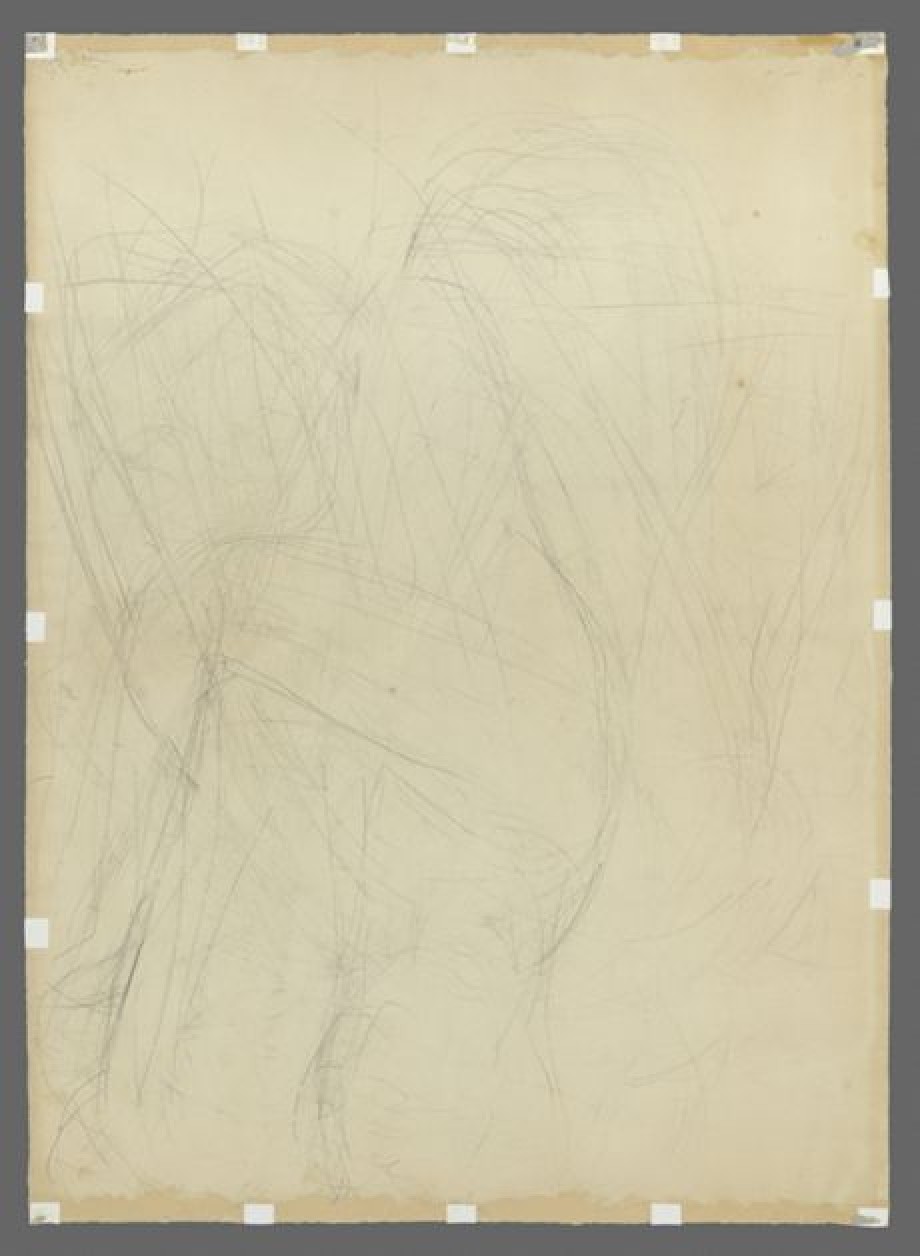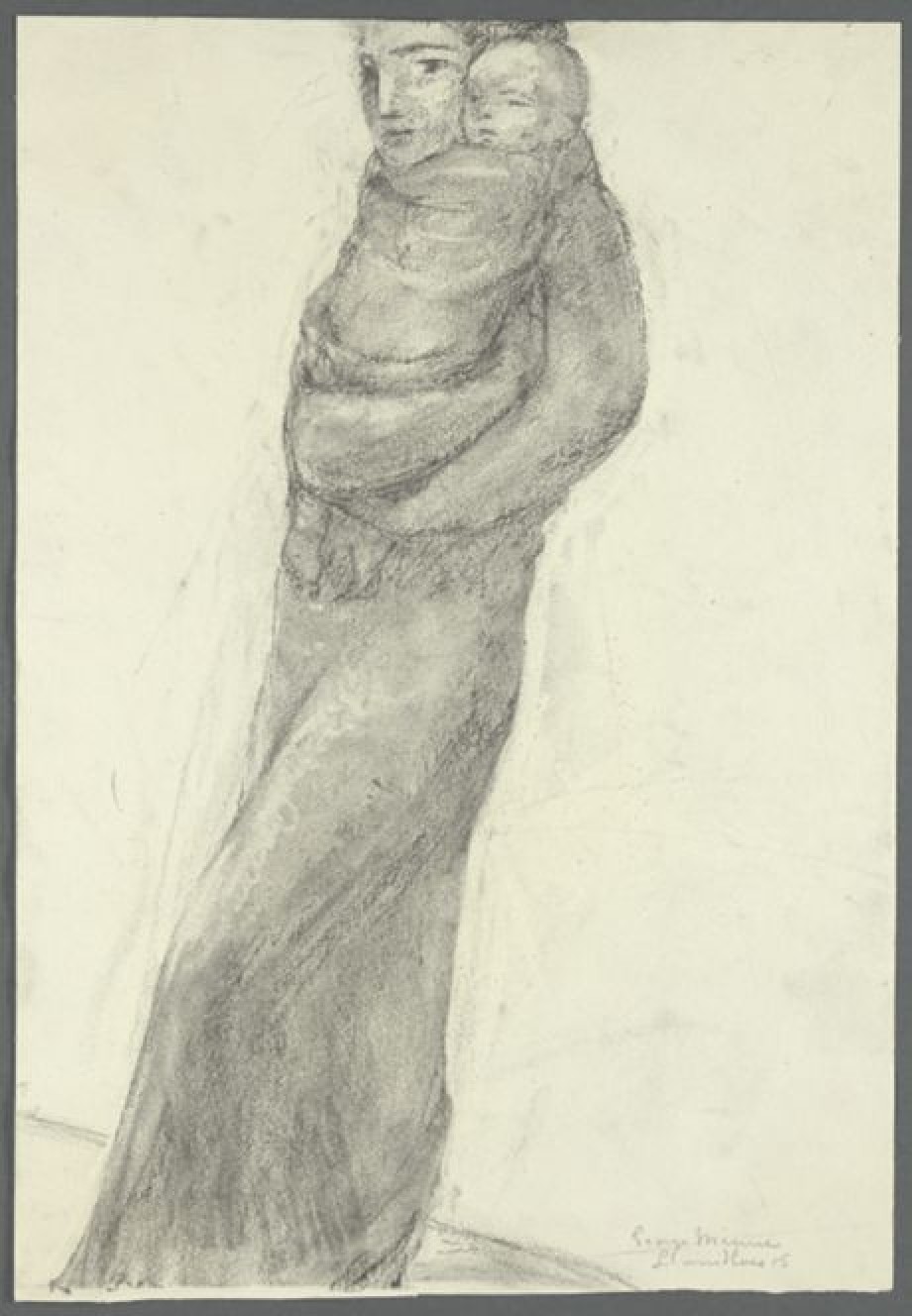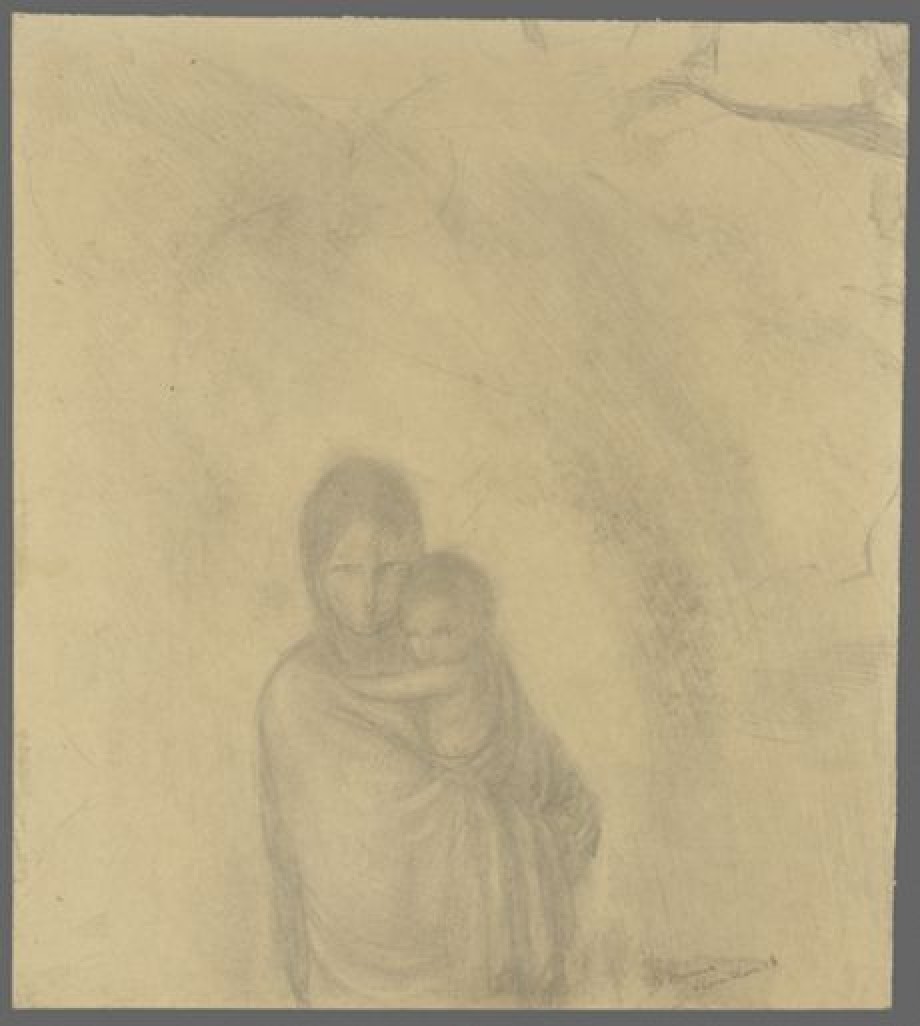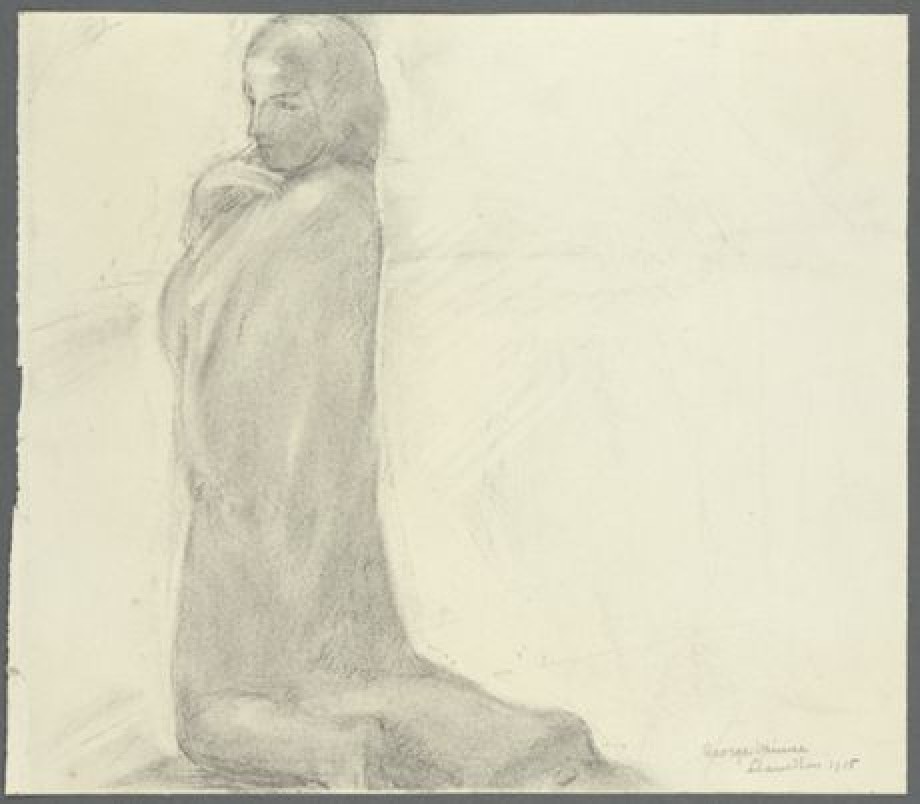
George Minne
More about George Minne
" ... small sculptures, monumentally big, closed, overflowing with ripe emotion, from inner suffering, from calm consideration-fixed in their simplification of form and full of rich divisions of surface. The nature is simplified as it were and the human body appears protracted and erected in awkward gestures. Yet, what an exceptional rhythm of surfaces and lines-also in the contorted renderings of the body, how this carries out the expression to a high power. Because Minne in no way seeks the "beautiful" line, the balancing equilibrium, the classic beauty and the comfortable admiration. There lies a wonderful, difficult to explain power in the sculptures of Minne-in the kneeling, the left and right stiff bowing figures..." With these words Karel van de Woestijne typified the work of George Minne, undoubtedly one of the most well-known symbolist sculptors in Europe. His modern spirituality, situated on the medieval mythic of Jan van Ruusbroec (1293/94-1381), fit in well with the attempts of the contemporary avant-garde towards what moved the soul. Many admirers in the time see in the stylised art of Minne also a revival of the Gothic.
With the strongly implemented simplification and the dramatic rendering of form in a few early works such as Mother Grieving over her Dead Child and The Prodigal Son, Minne simultaneously forms a bridge between the art of the last quarter of the 19th Century and the expressionistic avant-garde of the early 20th Century. The art of Minne perhaps is sprung from isolation, but is related to the contemporary experiments in other lands such as that of Paul Gauguin (1848-1903) and Charles Filiger (1863-1928) in France and Ferdinand Hodler (1853-1918) in Switzerland. Although he remained active until far into the 20th Century, Minne's most original and innovative creations came before 1900. His delicate youthful figures primarily have influence in the years after the turn of the century and in particular on the Austrian painters Gustav Klimt (1862-1918), Egon Schiele (1890-1918) and Oskar Kokoschka (1886-1980) and on the German sculptor Wilhelm Lehmbruck (1881-1919). Most of all in the latter we find Minne's influence on the formal and content level.
Minne is known in the first place as sculptor, but in addition to that he is also a draftsman and graphic artist. Like many sculptures of his generation they give their first ideas form on paper. In the medium he finds the possibility to think freely in three dimensions. His sketchbooks provide a good image of the manner in which Minne sought out various positions and thus arrives at their ultimate concept.
A few stand-alone drawings come about in Minne's most creative years as sculpture, between 1886 and 1900, the majority, however, are from the period during the First World War in the years of exile in Wales. But, also in the stand-alone drawings Minne thinks plastically, and he is in the first place a sculptor.
Minne is likewise much less known as a graphic artist. Yet, his illustrations for the works of the Belgian symbolist writers Grégoire Le Roy (1862-1941), Maurice Maeterlinck (1862-1949) and Emile Verhaeren (1855-1916) belong to the most significant examples of Belgian book design of the end of the 19th Century. With simple woodcuts, for which Minne undoubtedly found inspiration in the Middle Ages, he articulates the atmosphere of melancholy and mystique in the verses.
George Minne as sculptor
George Minne holds a distinct place in European Symbolism, as sculpture, draftsman and graphic artist. The medium of sculpture is not evident in that Symbolism. However, one of the distinguishing characteristics of Symbolism is precisely the veiling of the visible reality. By suggesting through a new world of dream and reflection, Symbolism alludes to an unspoken, interior emotion and goes against traditional sculpture that since the Renaissance represented the human figure in a realistic way. With his sculptural works-and also in his drawings-Minne thus goes radically against the idealistic artistic views of the academies and against the social realism of the 19th Century. He grounds himself, however, upon the existing themes, but he simultaneously adds a universal character to them. By making abstract from the telling aspect of the chosen themes, he arrives at a new iconography.
From the some 100 sculptural works that are known by Minne, more than two thirds of them originate from after 1900. However, the works that are before 1900 are the most authentic and most moving sculptures. In 1886 we see an artist, barely 20 years old, who for that moment develops a totally new, anti-classical and primitive language of form in the art of sculpture. With humble, moulded, delicate figures on a modest format, called ‘flippant trinkets' by the conservative press, the young artist reached a remarkable monumentality and he gave expression to a deep human spiritual feeling. In the sketchbooks from the period between 1886 and 1900, we see how Minne as a sketcher sought for the sculptural solution. In order to follow the creative process of various sculptures the sketchbooks are an important source of information.
Minne is no sculptor in the literal sense of the word. During his whole life he moulded his images in clay. The execution in plaster was also something that he normally did himself. The fine plaster material also rendered the delicate model of the sculptures. However, for the bronze castes or marble, bluestone or wood hewn version, Minne always called upon other practitioners. He was thus also not always involved with the production itself, which explains partially the uneven quality of his bronze-caste sculptures. The problem of authenticity is, however, thus more complex, in that even after Minne's death, sculptures were still caste and distributed.
Minne presented for the first time in exhibition in 1989 at the tri-annual Salon of Ghent, a year later with Les XX in Brussels. From 1890 on, he exhibited annually, first at Les XX, then later La Libre Esthétique in Brussels. The artist achieved international renown only with his participation in the Wiener Secession in 1900, where he showed, among others, the Kneeling Youth and the Fountain with Kneeling Youths from 1898, the highpoint in the oeuvre of the artist and also in the symbolist sculpture of the fin de siècle.
Between 1897-1899 a few works appeared that were closely linked with the ornamental Art Nouveau style, such as the Small Injured Figure from 1898 and the Woman Bathing from 1899. Also, the wooden image, The Bricklayer from 1897, originally meant for a stairwell in a home designed by Horta, was associated with the art-nouveau view in which sculpture took on a decorative function within interior design.
After 1900, Minne seems to have not been able to find the same creative drive as before. He still took on numerous assignments for portraits and memorial drawings and made replicas from previously made sculptures, in particular the Kneeling Youth. Around 1910 Minne went through a period of stylistic crisis. He abandoned every form of style and radically chose for a realistic approach from his model. After World War I, the theme of Mother and Child loomed large and Minne took up again a number of sculptures from his earlier period, such as Mother Grieving over her Dead Child. Thus he made in the 1930's also two replicas of the Fountain with Kneeling Youths; one is placed in the Emile Braunplein in Ghent and the other on the backside of the Parliament in Brussels. However, the later versions are missing the strong line and expressive emotion that are so distinguishing for the work prior to 1900. With there decorative and polished form the much more belong to the decorative art-deco style of the time.
George Minne as draftsman
Minne's earliest drawings date from his academic period between 1879 and 1886. For the most part, they are studies of the human body, probably assignments, sometimes after a live model, other after sculpture pieces from the classical antiquity, the Renaissance or the Baroque, His drawing style is yet somewhat clumsy, with hesitant contours and shaded surfaces. His numerous anatomical animal studies are from a later date, probably made around 1891 during a visit by the artist to Paris. The washed ink drawing The Shoemaker dates from 1887, and it is the only known stand-alone drawing by Minne from this period. The subject, however, is unusual amongst Minne's remaining drawings, but fits in with the typical 19th-century importance on crafted interior tableaux.
Minne's sketchbooks and separate study sheets allow us to follow the thought and work method of the sculptor. His sculptures already take on form on the paper; moulded studies by his hand, however, are preserved only by exception. A single sculpture is also based upon a dozen or so sketches, which are sometimes very hastily drawn.
The sketchbooks, coming from circa 1886-1888, show the various angles that the young sculptor was occupied with within his merely twenty years of age. A direct indication towards his sculpture work from the time is found central on one of the pages with the contours of Mother Grieving over her Dead Child.
In the sketchbook with figure studies, dating from around 1894-1896, we can see how Minne sought out various positions in order to ultimately bring them to realisation in sculptures such as John the Baptist and the Small Figure Kneeling. The book contains dominating studies of naked male figures and figure groups, in which for the first time Minne's preference for the extreme extension of figures comes to the fore. In the sometimes very free sketches we are witness to the genetic process of his sculptures, through which in particular Minne's attention to the three-dimensional form and an expressive movement is revealed in a direct, sometimes aggressive drawing style.
Some of the sketch pages are only a first draft for already or not-yet executed projects. In other pages the artist focuses on an essential element of the image, such as the backwards, light turning movement in The Prodigal Son, which in each of the rapid drawings he further develops.
For the Fountain with Kneeling Youths, there are a great number of studies known that at times the kneeling figures have as the subject and in others that of the supporting water basin. The preparatory sketches allow for us to see some surprising changes in Minne's concept. Thus, some studies show a group of four youths stepping around the basin, holding hands. Another sketch shows then again his attempts at the desired profile of the water basin. Minne continued to think about the concept of the fountain for his entire life. Ultimately he produced five models in plaster.
Drawings from sculptures are usually linked to their sculptural work. Thereby is the drawing seen as a phase in the artistic thought process. The preceding study work remains for the most part hidden from the outer world. The public at large only gets to see the produced sculpture itself. From the 19th Century on, however, sculptors begin to view the drawing steadily more as a discreet, self-standing medium. The duality in the artistic process, between sketched studies and stand-alone drawings, we find not only with Minne. Contemporary sculptures such as Auguste Rodin, Aristide Maillol and Constantin Meunier place equally expressed attention on the self-standing drawing.
One part of Minne's independent drawings comes about between 1886 and 1900, his most creative years as a sculptor. Between 1914 and 1919, Minne remains as an exile in Wales; in these years he designs not a single sculpture, but he is, however, indeed especially active as a draftsman. The series of some 400 articulated charcoal drawings from the time have a place in the separate rubric on Wales.
In the stand-alone drawings from before 1900, Minne goes through a clear evolution of style. In the ink drawings Mother Crying for her two Children (private collection) and Mother and Child Lying in her Arms, the emphasis is on the purely linear. Delicate and sparsely used shadings give the figures and the rockery in Mother Crying for her Two Children a certain volume and spatiality. In Mother and Child, Lying in her Arms, Minne brings depth into the work by the place of the vertical and horizontal shadings in contrast with the waves of the water. Completely different is the pencil drawing Mourning Mother from 1890 in which a more pictorial angle softens the contours. The drawing was purchased along with two others by Grégoire Le Roy. Mourning Mother and ... now belong to the MSK collection. In The Outcasts, Minne combines various aspects of his drawing style: the extension of the figures and the excessive formation by accentuating the joints and angular jutting body parts give the work an outspoken expressive character. The complex play of lines of the entangled figures, the waving linearly drawn hair and the majestic folds are associated with the art-nouveau style of Jan Toorop, among others.
George Minne as graphic artist
Minne is known in the first place as sculptor. However, his book illustrations belong to the most important usage of graphics in the Belgian fin de siècle. In the period 1889-1900, Minne illustrated six books in total from the symbolist writers Grégoire Le Roy, Maurice Maeterlinck and Emile Verhaeren. In his book design, the artist stood close by to the world of ideas of his Ghent friends from youth, Le Roy and Maeterlinck. Just as Maeterlinck steeped Minne in the early-medieval mysticism of Jan van Ruusbroec, in which concepts such as spirituality, sensuality and simple power are woven together.
Mon coeur pleure d'autrefois by Grégoire Le Roy is the first collection of writings that Minne illustrated. The illuminations are conceived as small text vignettes with an initial simple and drawn out delineation, through which the presentation is synthesised to its absolute essence. In each print, the white space commands, against which the image is drawn in hair-fine, fanciful contour lines. The prints are no literal illustration of the textual content, but rather enhance the atmosphere of melancholy and weariness of life that speaks from the poems. The cover subject is connected with the sculpture of the Mourning Mother with two Children from 1888 and with the like-named drawing.
For the title page of the theatre piece La Princess Maleine by Maurice Maeterlinck, Minne designed an image that tells a scene from the dramatic piece and at the same time suggests the tragic end of the protagonists. The drawing ultimately did not appear in the work by Maeterlinck, but was printed in the Brussles' newspaper La Jeune Belgique. The heliogravure is iconographically related to the frontspiece that the artist designed for Maeterlinck's poetry collection, Serres Chaudes. In contrast to the illustration that Minne drew for Mon coeur pleure d'autrefois, he chose here for a decorative and stylised play of line that covers the entire image surface.
In the course of the 1890's, the artist evolved towards a style that was heavily influence by the medieval woodcuts and folk prints. In addition, the contemporary British book design of Aubrey Beardsley and Edward Burne-Jones (1833-1898) is an example for Minne. His illustrations take on a more telling drama, whereby a busy, often parallel play of lines commands the image surface. The prints for Trois Petits Drames of Maeterlinck from 1894 are an example of this, as well as the four woodcuts that Minne makes for Les Villages illusoires of Verhaeren. Both with the three one-acts of Maeterlinck as with the poetry collection of Verhaeren, the text and image are again independent of each other, which goes along with the general view of Symbolism. The exceptional prints depict Minne's interpretation of the text, much more than they literally illustrate them.
Around 1900 Minne made seven illustrations for the German translation of Maeterlincks Soeur Béatrice. The story is completely based upon the Middle Dutch legend and shows the preference of the symbolists for the Middle Ages. Also, the prints of Minne hearken to a medieval reminiscence; in particular the presentations of the veiled nuns recall the sculptures of Claus Sluter (1350-1406). Such figures, however, are already present in Minne's illustration for Alladine et Palomides, one of the three one-act plays of Maeterlinck, and in his image group The Holy Women at the Tomb. Schwester Beatrix is the last book for which Minne provided the illustrations. Stylistically the prints are associated with the style of Jan Toorop and Charles Doudelet (1861-1938).
In the Wiener Secession of 1900, in addition to sculptures and drawings, Minne also presented a woodcut showpiece, The Baptism of Christ. The print dates from 1899 and is the only known print to date of the artist that may be viewed as a stand-alone graphic work. The sheet is part of a collection Germinal with twenty prints from various prominent artists, published by Julius Meier-Graefe. The meandering play of line in The Baptism of Christ is related to the illustrations for Schewester Beatrix.
Text: Helke Lauwaert
